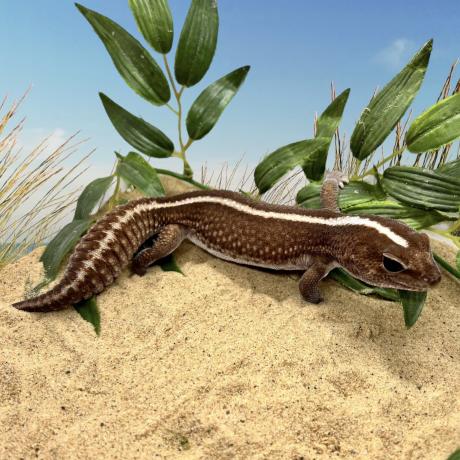

African Fat-Tailed geckos are the second most widely kept eublepharine species of gecko. They have a nice, calm nature making them a great pet for beginners or experienced keepers looking for an alternative to the leopard gecko.
| Origin | West Africa |
|---|---|
| Environment | Scrublands, Savannah |
| Adult Size | 12cm |
| Suitability | Beginner |
| Lifespan | 10 Years + |
| Temperament | Docile |
These animals can be compared with the popular leopard geckos in length and weight. Baby African fat-tail geckos generally hatch around 4-5cm in length (snout to vent) while adults tend not to exceed 12cm. Most adult African fat-tailed geckos generally weigh 40-65g once they reach their adult size, with males often being the larger of the two sexes.
African fat-tailed geckos come in two naturally occurring forms, banded (similar to that of leopard geckos) and striped. The base colour in this wild type/normal animal is from beige to orange/brown. Banding goes along the length of the body, head and tail and is generally dark brown in appearance. Fat-tail geckos generally have a white/cream underbelly and some animals have a stripe which will be white/cream line down their dorsal.
Where are African Fat-Tailed Geckos from?
African fat-tailed geckos Hemitheconyx caudicinctus originate from West Africa and are the second most widely kept eublepharine (moveable eyelids) species of gecko. They inhabit areas of savannah and scrublands throughout Benin, Ghana and Togo. These animals are primarily nocturnal and would take refuge during the day in underground burrows, under rocks or in rotting wood.
African fat-tailed geckos can be kept in vivariums either alone or within a sexed group. Several females can be housed with a single male in larger vivaria, however you must carefully monitor each animal and ensure that they remain happy and stress free. It is advisable not to keep males with females unless the overall intention is to breed your animals. Once a group is established it can be difficult to introduce new animals due to territory issues. Males should never be housed together as they will often fight to the death as with many other species of gecko. We would advise to house your animals singular in most cases with a minimum floor space of 30 x 12".
For substrate we would advise using a fine orchid bark or sandy/soil mix. African fat-tailed geckos are shy animals and it is important to provide them with plenty of hides and shelters. A humidifying shelter is essential for these animals and when provided will allow them to select the substrate moisture and humidity level they require.
For heating you can maintain the temperatures by using either a basking lamp with a guard or a heat mat for hatchling enclosures, a thermostat should control all heat sources to avoid risk of overheating.
The aim is to provide a basking spot that maintains at 32°C, with it dropping no cooler than 25°C throughout the rest of the enclosure. This will allow the animal to thermoregulate efficiently. A nighttime temperature drop of 5°C is advisable, a good quality thermostat and digital thermometer will help you achieve this. We recommend using a low level UVB light. Recent studies have shown that their skin is twenty times more absorbent than that of a bearded dragon. After all, they are crepuscular and whilst limited, they would have some natural exposure to the sun in the wild. Providing 12 hours of UVB light will also help simulate a natural daylight cycle and will aid calcium absorption via access to natural D3. With this in mind, it can only be beneficial to your gecko with access to UVB.
When feeding you should remember that African fat-tailed geckos are insectivores. This makes their care relatively simple as they can be fed on an array of live food purchased from a store such as ourselves. We generally feed our African fat-tailed geckos on a diet of mealworms and silent brown crickets, we also give them the occasional locusts.
Like with all lizards, you must use a good quality dusting powder to provide essential calcium and vitamins to your fat tailed gecko. The traditional method of application is to use a spare live food tub or empty cereal container to coat the insects lightly in whichever dusting powder you are providing. We’d advise dusting your insects on every feed when your gecko is growing but to alternate between calcium and vitamin powders with the ratio of (2.1).
Handling African fat-tailed geckos is a great experience due to their docile nature and slow movements making them very easy to hold and work with. Young fat tails can be skittish until they get used to regular handling but when compared to leopard geckos we do find them much easier. African fat-tailed geckos will normally walk calmly onto your hands if placed in front of them and then they can be gently scooped up. Remember that this should be done close to the floor to begin with, to prevent any accidental falls. Never unnecessarily restrain your animal or it could cause them a great deal of stress and your animal could also drop its tail as a consequence. It is worth noting also that you should never hold your gecko by its tail.
Sexing African fat-tailed geckos can be done visually once they reach a juvenile age. Males will start to develop pre-anal pores above the vent and hemipene bulges below. Comparing both sexes side by side it becomes very obvious what you are looking for and with further experience you can start to sex them at a younger age. African fat-tailed geckos eggs like leopard geckos, can be incubated at particular temperatures to determine the eventual sex of the animal.
If you're thinking of getting an African fat-tailed gecko as a pet, please remember they can live up to 20 years old.